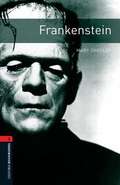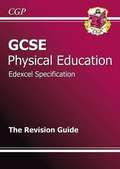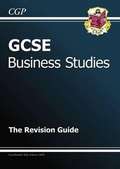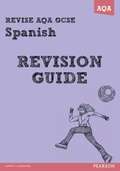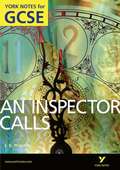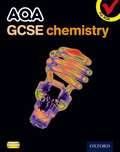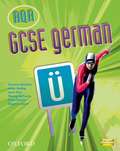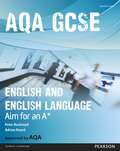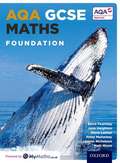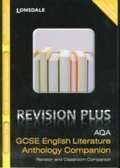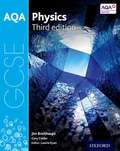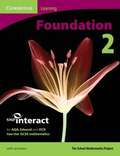- Table View
- List View
Oxford Bookworms Library, Stage 3: Frankenstein (2007 edition) (PDF)
by Shelley, Mary|Nobes, PatrickThe Oxford Bookworms Library offers enjoyable reading at seven levels (Starter to Stage 6). To find your required reading level please take the Oxford Bookworks reading level test. Victor Frankenstein thinks he has found the secret of life. He takes parts from dead people and builds a new 'man'. But this monster is so big and frightening that everyone runs away from him - even Frankenstein himself! The monster is like an enormous baby who needs love. But nobody gives him love, and soon he learns to hate. And, because he is so strong, the next thing he learns is how to kill...
Oxford Bookworms Library, Stage 3: Tales of Mystery and Imagination (2007 edition)
by Poe, Edgar Allan|Naudi, MargaretThe Oxford Bookworms Library offers enjoyable reading at seven levels (Starter to Stage 6). To find your required reading level please take the Oxford Bookworks reading level test. The human mind is a dark, bottomless pit, and sometimes it works in strange and frightening ways. That sound in the night ... is it a door banging in the wind, or a murdered man knocking inside his coffin? The face in the mirror ... is it yours, or the face of someone standing behind you, who is never there when you turn round? These famous short stories by Edgar Allan Poe, that master of horror, explore the dark world of the imagination, where the dead live and speak, where fear lies in every shadow of the mind...
The Child in Time
by Ian McewanThe Child in Time opens with a harrowing event. Stephen Lewis,a successful author of children's books, takes his three-year-old daughter on a routine Saturday morning trip to the supermarket. While waiting in line, his attention is distracted and his daughter is kidnapped. Just like that. From there, Lewis spirals into bereavement that has effects on his relationship with his wife, his psyche and time itself.
CGP GCSE Physical Education for Edexcel Specification - The Revision Guide
by Richard ParsonsThis book is for anyone doing GCSE Edexcel Physical Education. GCSE PE is all about understanding how physical activity and your lifestyle can affect you and your body. nbsp; Happily this CGP book includes all the PE facts you need to learn for the exam. And in true CGP style, we've explained it all as clearly and concisely as possible. nbsp; It's also got some daft bits in to try and make the whole experience at least vaguely entertaining for you.
CGP GCSE Business Studies: Revision Guide
by Richard ParsonsSuitable for students just starting their GCSEs (in Year 10).
GCSE Science for AQA - Science Student Book (PDF)
by Edmund Walsh Emma Poole Louise Petheram Leslie Owen Charles Golabek Aleks Jedrosz Mary JonesThis book will provide you with complete coverage of the new AQA GCSE Science specification.
Spanish: Revision Guide (PDF)
by Leanda Reeves Tracy TraynorThis Revision Guide delivers exam preparation, covering one topic per page and closely matching the AQA specification. Target grades on the page help you to progress at the right speed. Exam Alerts highlight common pitfalls and misconceptions in exam questions. Audio files are available free on a companion website to provide realistic question practice.
An Inspector Calls: York Notes for GCSE (PDF)
by John Scicluna J B PriestleyYork Notes for GCSE are written to give an understanding of the text and the exam, they include: nbsp; An enhanced exam skills section: with essay plans, sample answers and guidance on understanding the question. Useful content: key quotes, checklists, study tips and revision activities to help revise efficiently and remember everything needed to write the best answers
OxBox: AQA GCSE Chemistry (PDF)
by Gardom Hulme PhilippaResources for the 2011 AQA GCSE Science specifications have been specifically developed by listening to teachers and addressing their neds. Contents include: Atoms, rocks, metals and fuels; Polymers, plant oils, the Earth and its atmosphe; Structures, properties and u; Rates, energy, salts and electroly; Water, energy and the periodic table; Analysis, ammonia and organic chemis. try
AQA GCSE German Student's Book (PDF)
by Corinna Schicker Dagmar Sauer Lynne Erler Anke Neibig Michael Spencer Clare Parker Morag MccrorieAQA GCSE German is ideal for teaching the AQA specification. It offers a range of targeted resources, including differentiated Exam Skills Workbooks, a Grammar Workbook and a helpful Teacher Book. It has support for controlled assessment integrated throughout and exciting, easy-to-use software.The Student Book is packed full of material that is of interest to young people. The content is an exact match for the AQA specification and topics are translated into practical 'how to' tasks in each unit. The Student Book focuses on developing key linguistic and learning skills throughout. Grade target boxes show students how to improve and grammar is highlighted throughout as well as at the end. The book itself is a larger size than in other courses and so is far more accessible to students.The modern and lively approach of the material will inspire students and the course develops transferable skills, offering a problem solving approach to language learning for all GCSE German students.
AQA GCSE English and English Language: Aim for an A* (PDF)
by Peter Buckroyd Adrian BeardWritten by highly experienced Chief and Principal Examiners, this grade-banded Student Book for AQA GCSE English 2010 provides authoritative, grade-focused support to help every student get the best results. It also supports the precise needs of each student providing specific advice, activities and sample answers to enable them to reach their full potential. Contents includ: Read, writing, Studying spoken langua, Exam pract.
AQA GCSE Maths: Foundation (PDF) (400MB+)
by Peter Mullarkey June Haighton Matt Nixon Stephen Fearnley James Nicholson Steve Lomax400MB+ File Request - email bookshare@rnib.org.uk to request this title by WeTransfer. AQA GCSE Maths, Foundation Student Book has been specially written by a team of maths experts for the Foundation tier of AQA's new GCSE specification 8300. Designed to fully support the new style of assessment, the book adopts a clear style to focus on delivering exam success via the careful development of fluency and problem solving practice.Powered by MyMaths the book links directly to the ever popular web site offering students a further source of appropriate support.
Mechanics 1 For Edexcel (PDF)
by The School Mathematics ProjectBased on extensive feedback from teachers, these popular A Level titles have been written by the experienced team that produced SMP Interact for GCSE. These are clear, user-friendly texts that both teacher and student will enjoy using. Each chapter's objectives are clearly set out and new concepts are carefully developed in a way that involves the student. Worked examples are designed to clarify ideas and techniques, and there is plenty of well-graded practice and revision, including past exam questions that show the standard required. Key points are highlighted as they arise and are gathered in a summary at the end of the chapter, where there is also a self-assessment section. Each book contains a detailed contents analysis and the chapters are structured so that you can easily tell what part of the specification you are covering. Opportunities for classroom discussion are marked, and starred questions provide extra challenge where needed.
Lonsdale GCSE Revision Plus: AQA English Literature Anthology Companion (PDF)
by Paul BurnsSuitable for the new GCSE English curriculum starting in 2010, this revision guide focuses on the poems and short stories that are found in the AQA anthologies, Moon on the Tides and Sunlight on the Grass. It provides detailed information about each of the poems in the four clusters, and each of the seven short stories.
AQA GCSE Physics (PDF)
by Lawrie Ryan Jim BreithauptThe UK's bestselling GCSE Science series has now been updated and specifically tailored for the new 2016 AQA GCSE Science (9-1) specifications. Supporting your students on their journey from Key Stage 3 and through to success in the new linear GCSE qualifications, this series help students and teachers monitor progress, while supporting the increased demand, mathematical content, and new practical requirements. This Student Book offers:- Fully integrated and differentiated support tailored to the new 9-1 GCSE specification - Practical feature and chapter to support the required practicals and skills - Maths chapter and worked examples to support the increased mathematical demand of the new GCSE - Synoptic links and questions to develop synoptic skills - Differentiated and ramped questions based on our new GCSE assessment model - New practice questions including maths, practical, synoptic, and extended writing
Red Grouse (Large Print)
by Rnib BookshareThis is a Red Grouse shown from the side. There is a locator dot shown, which will be at the top left of the page when the image is the right way up. Its head, which is facing to the left, has a short blunt beak. One eye is visible, and above this, is its distinctive red wattle. Slightly down and to the right of the head is the wing. Down from this is the Grouse's chest, and down again are its two sturdy legs. To the very right of the picture its short tail can be found. The Red Grouse is covered with chestnut brown feathers.
SMP GCSE Interact 2-tier Foundation 2 (PDF)
by The School Mathematics ProjectThis series is an excellent preparation for the linear and modular mathematics GCSE specifications offered by AQA, Edexcel and OCR. The books have been especially praised for helping raise the confidence of students, who as a result have a better understanding of the mathematics and a clearer self awareness of what they've learned. The book continues the confidence-building style of the preceding books, approaching the hardest topics in a straightforward way that takes account of students' known learning difficulties and matches the level of demand of the exam papers.
Arm Bends (Large Print)
by RnibThis page shows the arm, shoulder and two muscles seen from the front. The shoulder is in the top right. A locator dot and title are shown. These must always be at the top left of the page when the image is the right way up. The lower arm goes horizontally to the left centre of the page. Left and right of the vertical humerus bone are muscles. When the biceps (left of the humerus) contracts it pulls on the lower arm so that it moves upwards. The triceps (right of the humerus) relaxes.
Arm Bends (UEB Contracted)
by RnibThis page shows the arm, shoulder and two muscles seen from the front. The shoulder is in the top right. A locator dot and title are shown. These must always be at the top left of the page when the image is the right way up. The lower arm goes horizontally to the left centre of the page. Left and right of the vertical humerus bone are muscles. When the biceps (left of the humerus) contracts it pulls on the lower arm so that it moves upwards. The triceps (right of the humerus) relaxes.
Arm Straightens (Large Print)
by RnibThis page shows the arm, shoulder and two muscles seen from the front. A locator dot and title are shown. These must always be at the top left of the page when the image is the right way up. The shoulder is in the top right. The arm goes down to the bottom left of the page. Left and right of the vertical humerus bone are muscles. When the triceps (right of the humerus) contracts, it pulls on the lower arm so that it moves downwards. The biceps (left of the humerus) relaxes.
Arm Straightens (UEB Uncontracted)
by RnibThis page shows the arm, shoulder and two muscles seen from the front. A locator dot and title are shown. These must always be at the top left of the page when the image is the right way up. The shoulder is in the top right. The arm goes down to the bottom left of the page. Left and right of the vertical humerus bone are muscles. When the triceps (right of the humerus) contracts, it pulls on the lower arm so that it moves downwards. The biceps (left of the humerus) relaxes.
Breathing in (Large Print)
by Rnib BookshareThis diagram shows the outline of the chest with the lungs and respiratory tract in cross section. A locator dot and title are shown. These must always be at the top left of the page when the image is the right way up. The chest is facing you and is surrounded by an image border. There are also two thumbnail diagrams at the bottom of the page. At the top centre of the page is the larynx. The respiratory tract runs down and divides, going left and right into each lung. The cut sections of the ribs surround the lungs to the left and right. Between them towards the bottom of the diagram is a slightly curved horizontal thick line representing the diaphragm. The ribs have lifted upwards and outwards, and the diaphragm has contracted resulting in it flattening. This increases the capacity of the chest which lowers the pressure and draws air in. The two thumbnail diagrams at the bottom of the page show the shape of the chest when breathing in on the left and out on the right.
Breathing in (UEB Contracted)
by Rnib BookshareThis diagram shows the outline of the chest with the lungs and respiratory tract in cross section. A locator dot and title are shown. These must always be at the top left of the page when the image is the right way up. The chest is facing you and is surrounded by an image border. There are also two thumbnail diagrams at the bottom of the page. At the top centre of the page is the larynx. The respiratory tract runs down and divides, going left and right into each lung. The cut sections of the ribs surround the lungs to the left and right. Between them towards the bottom of the diagram is a slightly curved horizontal thick line representing the diaphragm. The ribs have lifted upwards and outwards, and the diaphragm has contracted resulting in it flattening. This increases the capacity of the chest which lowers the pressure and draws air in. The two thumbnail diagrams at the bottom of the page show the shape of the chest when breathing in on the left and out on the right.
Breathing in (UEB Uncontracted)
by Rnib BookshareThis diagram shows the outline of the chest with the lungs and respiratory tract in cross section. A locator dot and title are shown. These must always be at the top left of the page when the image is the right way up. The chest is facing you and is surrounded by an image border. There are also two thumbnail diagrams at the bottom of the page. At the top centre of the page is the larynx. The respiratory tract runs down and divides, going left and right into each lung. The cut sections of the ribs surround the lungs to the left and right. Between them towards the bottom of the diagram is a slightly curved horizontal thick line representing the diaphragm. The ribs have lifted upwards and outwards, and the diaphragm has contracted resulting in it flattening. This increases the capacity of the chest which lowers the pressure and draws air in. The two thumbnail diagrams at the bottom of the page show the shape of the chest when breathing in on the left and out on the right.
Breathing out (Large Print)
by Rnib BookshareThis diagram shows the outline of the chest with the lungs and respiratory tract in cross section. A locator dot and title are shown. These must always be at the top left of the page when the image is the right way up. The chest is facing you and is surrounded by an image border. There are also two thumbnail diagrams at the bottom of the page. At the top centre of the page is the larynx. The tract runs down and divides, going left and right into each lung. The cut sections of the ribs surround the lungs to the left and right. Between them towards the bottom of the diagram is a curved horizontal thick line representing the diaphragm. The ribs have fallen downwards and inwards, and the diaphragm has relaxed resulting in it rising. This decreases the capacity of the chest which forces air out. The two thumbnail diagrams at the bottom of the page show the shape of the chest when breathing in on the left and out on the right.
